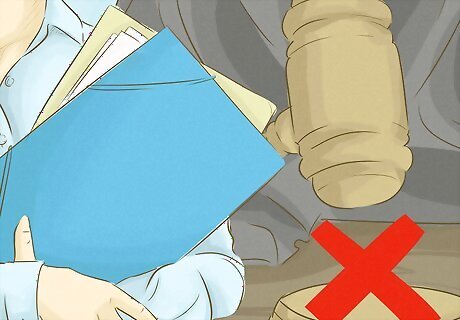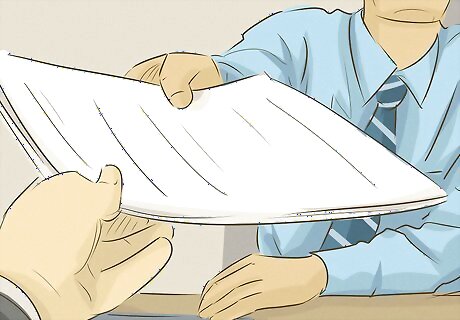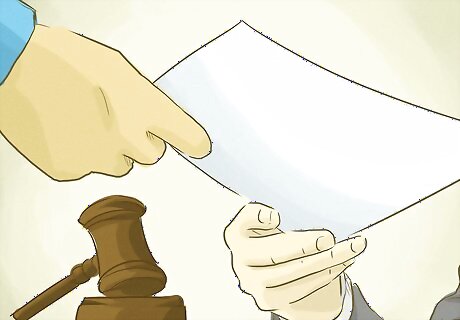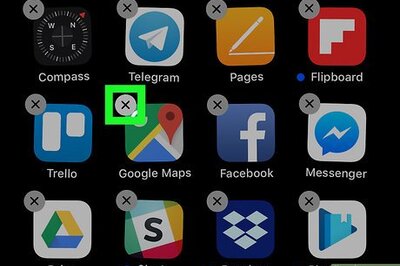
views
Understanding Ex Parte Contact

Do not contact a judge if you are currently involved in a case. For most court cases, ex parte communication is strictly prohibited, as it can impact the decision of the case. If you are currently in a case, you are not permitted to contact a judge outside of the courtroom. Instead of contacting the judge directly, you can file a written motion. In most situations, whenever you need to request something from the court, you would do so in a motion. This ensures all parties have the same information available to them as the judge. If you are on the jury, you can only contact a judge in written form unless a lawyer is present.
Contact the judge in the presence of a lawyer if you are on the jury. You may have a question about the evidence or the judge's instructions overall. If this is the case, draft a note, deliver the note to the bailiff, and they will give the note to the judge.

Submit a written explanation if you are contesting a traffic citation. In certain cases, ex parte communication is allowed, including traffic infractions. If you are contesting a traffic ticket, you are legally allowed to submit a written explanation of what happened. The instructions to do this are outlined on your ticket, and there you can find the correct address to mail your summary. Oftentimes, a pre-addressed envelope is included with the ticket.

Contact a judge regarding an emergency request for a restraining order. The other instance in which a judge will accept ex parte communication involves emergency situations regarding restraining orders. If you are in need of a temporary restraining order out of fear of your safety, you can call or write a judge explaining the circumstances. Then, the judge can issue the restraining order based on their decision. If a long-term restraining order is desired, you must go through the standard trial process.

Ask the judge about scheduling and case status. Communication about your case status or scheduling requests is permitted by law. Send a letter or call a judge if you want to know about the outcome of your case or if you have a question about rescheduling your court appearance. While you may not get in contact directly with the judge, you can still get assistance by a legal representative.
Filing a Motion

Write a motion if you want the judge to take a specific action. This is the closest you can get to conversing with a judge about your current case. If you have a lawyer, they can help you draft the motion and submit it. If you want to draft the motion yourself, find a sample online to help guide you. Title your motion, introduce yourself, explain the facts and evidence, and add a conclusion. Then, complete your motion and add affidavits for supporting evidence. For example, if you want the judge to hear why you are the better legal guardian in a custody case, you can file a motion explaining why you are the ideal caretaker. If you are in a court case and want a judge to revisit a previous case, you can file a motion to reopen. For example, you can write something like, “The Defendant, Tina Johnson, in the above-captioned case, respectfully requests that the court hear her pleas regarding custody concerns.” Depending on your circumstance, there may be an additional form to submit along with your motion. The court clerk will provide this form for you if it is required.

Send a copy of your motion to the other party before the court. To follow proper protocol, your motion must be shared with other party members before you give it to the judge. Especially in small claims courts, the other party has to know about any communications you make with the court. Give a stamped hard copy of your motion to each party member. This way, each party is exposed to the same information as presented in court. If the other party has a lawyer representing them, provide the copy of the motion to the lawyer. The other party has 15 days to file a written response regarding your motion. After the other party responds, the motion transfers to the judge so they can make their decision.

File your letter with the court. If you have a lawyer, they will take care of this for you. If you are representing yourself, visit the courthouse and drop off the motion with the court clerk. When you do this, provide your original signature. The court clerk will stamp the copies of your motion with the date, so you can give them to the other party. Then, the judge will use your motion to make their decision. In some courts, a filing fee may be required. If this is the case, the court clerk will request the fee for you when you file the motion. When you file the motion, you must provide documentation that you sent the motion to the members of the other party. The date stamp is adequate proof. If you don’t get proof, the judge will do this for you.

Attend a hearing after the judge schedules it. Not all cases require a court hearing regarding your motion, but if your judge would like to schedule a hearing, they will contact you regarding the date and time. Then, show up 5-15 minutes early wearing professional attire. The hearing is where the judge will present their official decision regarding your motion. When you file the motion, you can ask the court clerk what their process is regarding scheduling hearings. Some courts may have you fill out a Notice of Hearing form when you drop off the motion. If so, you must send a copy of this to the other party as well.
Finding a Judge's Contact Information

Visit the website for your district. If you want to find the contact phone number and/or mailing address of local judges, search online for the judicial district website nearest your area. Here, you can view all of the judges in your local district or find the contact information for a particular judge, if applicable. Do this if you want to ask a judge a question regarding a specific court case, handling jury matters, attorney admissions and bar memberships, or naturalization concerns. While ex parte communication refers to the particular judge in your case, it is not a good idea to contact another judge. This may be seen as trying to converse confidentially, which can negatively impact your case.

Look for a “Contact Us” tab. When you reach the local district website, look for a “Contact Us” or “Contact” link at the top. Click on this link to bring you to the contact page. This page lists judges alphabetically and provides most of their addresses, phone numbers, divisions, and sections.

Browse the list of judges in the circuit. Scroll through the list of judges, and select the judge you’d like to contact. All of the judges in your district are listed on this page. Some websites may have specific links for particular judges, where you can read more about them and their work. You can choose your judge based on court type, such as district, bankruptcy, probation and pretrial services, defenders, and appeals. Ultimately, the judge you contact is based on personal preference. You can select the judge who is closest to your location or most closely helps your situation, for example.

Write a letter to a judge as long as you are not in a current case. To start the letter, indicate what the letter is regarding, and identify yourself and your profession. Then, tell the judge what you want and provide reasons why they should grant your request. Don’t forget to address the envelope before you send it. Alternatively, you can call the judge. However, you will most likely get a voicemail, as judges are very busy people. They may return your call or have a legal representative contact you. Say something like, "Dear Judge Smith, My name is Paul Johnson, and I am a teacher in York County, Pennsylvania. I am wondering what the outcome of the case with Mr. Ryan Simms was, as he was a longtime student of mine."
Contacting a Judge as a Jury Member
Provide a written note to the bailiff regarding questions or clarification. If you have a question relating to the evidence or the judge's overall instruction, proper protocol is to write a note to the judge. Start your note with "Dear," followed by the judge's last name. Then, write your question and mention your jury involvement. Then, deliver the note to the bailiff, who can then give the judge your note. The judge will respond in writing, or they will verbally respond to the entire jury. Do this if you want to clarify a piece of evidence, for instance.
Ensure a lawyer is present if contacting a judge in person. If the judge responds to your request in person in front of the entire jury, you may be able to ask direct questions. If this is the case, ensure a lawyer from both sides of the case is present. It is imperative that all facts and case information remain available for both parties. This is often the only case in which you can directly talk to a judge regarding the case.
Check with a lawyer you are confused about the contact requirements. It can get confusing as to how to contact a judge as a jury member. If you have any questions, ask a lawyer on site or the bailiff. They can clarify the confusion and point you in the right direction. For example, if you are unsure as to whether you can ask a judge a question in private, as the lawyer.


















Comments
0 comment